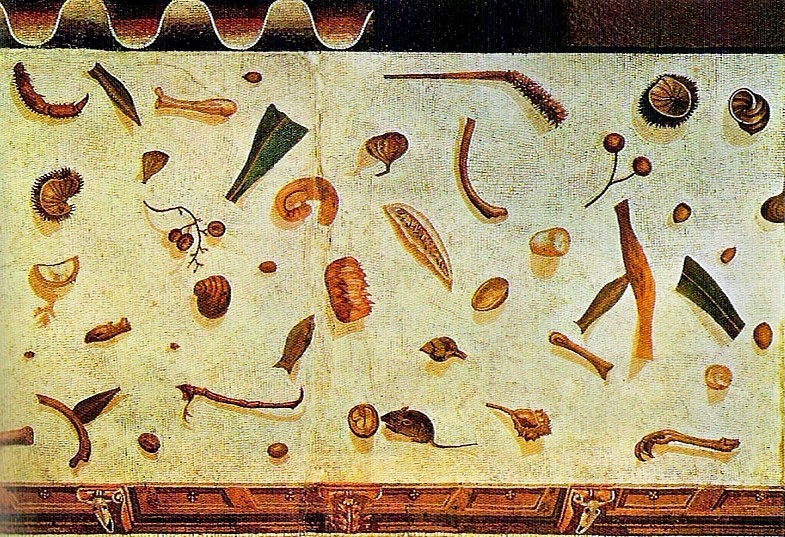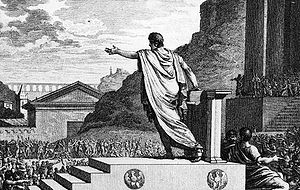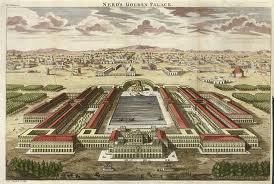ROME AND THE ETRUSCANS
Rome was founded in the 8th century BC while Etrurian history (north of Rome) dates back to the first millenium BC, with its golden period between the 8th and the 6th century BC.
From a small untidy village overlooking the Tiber River Rome became a metropolis spanning seven hills.
Its inhabitants were diverse, mainly a mixture of Italic people with their own cultures and beliefs. There were many dialects but the common language was Latin. Etruscan became the official language when the city was under the authority of Etrurian kings.
The Etruscan civilization was an advanced culture that benefitted from the Greeks (with colonies in the sourthern tip of the penninsula) from whom they borrowed the alphabet. Etruscans were masters in the arts, in engineering and in construction. Etruscan architects and workers built most of Rome as well as the protecting walls. They thought up a functional sewage system and ways to save topsoil by cutting drainage canals in rocks.
The last in a long line of kings from Etruscan nobility was Lucius Tarquinius Superbus. A scandal seems to have sparked an upheaval that ended Etruscan control over Rome. It appears his son violated a matron of the city; it could have been a rumor or the story of a woman scorned but Tarquinius was an unpopular leader and was overthrown.
High-placed citizens and nobilty grouped in 509 BC to form the Roman Republic which lasted almost five hundred years.
Constantine managed through ruse to be crowned emperor in 324. He was the first to convert to Christianity and made it the official religion. Foreseeing more trouble from the north he relocated to the ancient city of Byzantium overlooking the Black Sea. He thus formed two entities: the West Roman Empire in Rome and the East Roman Empire in Byzantium, later renamed Constantinople.
The first wave of northern tribes entered Rome soonafter the transfer, first by the Gauls in 387 and by the Visigoths in 410. The city faced an imminent attack by the Huns but was spared when their leader Attila died. The Vandals, apparenlty the worst of the lot, arrived in 455. Rome was sacked by the Ostrogoths in 546, by the Arabs in 846 and by the Normans in 1084. In 1527 it was pillaged by 34,000 mutinous soldiers when King Charles I of Spain didn't pay up after they defeated the French in Italy. The men retaliated by plundering Rome, which had only 5,000 soldiers. Raised in a multicultural environment, Charles is supposed to have said: "I speak Spanish to God, Italian to women, French to men and German to my horse."
In the 10th century Pope John XII rehabilitated the notion of the Roman Empire. He called it the Holy Roman Empire (Sacrum, Holy, was added a few years later) and made it official in 962 with Charlemagne’s coronation as the first Emperor. The choice of a king for the title was a strategy to strengthen the Churche's military power. There was nothing holy about the pope's motives, Charlemagne was German and there was no territory to call an empire. The disagreements between pontifs and kings created even more confusion over the pecking order in Europe's backyard.
The East Roman Empire, after surviving a thousand years' attacks from Arab and non-Arab Muslims, disinegrated when Constantinople fell to the Ottoman Turks in 1453. The loss of Constantinople (the Church's last stronghold to the east against the Muslims) was a fatal blow to the Holy See, whose credibility was already tenuous in the social and culural explosion of the Renaissance.

Though Caesar was responsible for many reforms and squelched corruption he assumed manners that didn’t sit well with everyone. He realized that a total overhaul in the system was the only solution to stop the problems that beleaguered the Republic, but many members in the Senate did not want to see change, including Cleopatra’s lover Marc Anthony and his cronies. They planned to kill him, which they did in 44 BC. Mark Anthony took Caesar’s place but was ousted by Caesar’s nephew Gaius Octavian. Octavian restored order in the military and included people from different ethnic backgrounds into politics and Roman society. He was given the honorable title of Augustus and became Rome’s first Emperor.
The young Rebublic needed manpower to defend Rome from the Etruscans as well as the Latin League, and to this end the nobles assured the Popular Party equal representation. An agreement was reached but predictably promises were not kept and Rome was still ruled by the nobility. The Plebeians, who protected the rights of the common people, had less respresentation than the Patricians, backed by the aristocrats. The plebians protested continuously against the social injustices imposed by the Senate (the Senate had become the main body that controlled all aspects of government: legislative, executive and judiciary).
In 475 BC, just before an imminent attack on the city by the Etruscans, the plebs agreed to join forces only if they were given better representation, with their own officials: tribuni plebes. The accord was a victory for the working class though it would take another two hundred years of social activism before plebeians were allowed to hold government positions.
Rome underwent a stage of prosperity, from 10,000 the city’s population grew to a million citizens and over time the Roman Republic had pushed its boarders to the fringes of Europe. Clever military tactics and respect for other people’s cultures made this period relatively stabile compared to their neighbors until the Gauls from the north attacked the city in 390 BC. Undaunted, the Romans rebuilt and continued their ambitious plans to rule the Mediterranean.
The ultimate goal was Athens, the prize because of the city's strategic and symbolic importance in the region. Roman generals overpowered the Macedonians and the Carthaginians and set off to capture Greece and its colonies.
General Sulla entered Athens in 88 BC, the population was starving after a year of seige and he killed everyone.
Carthage, located in a natural inlet on the Tunisian coast, had invaded all of North Africa and Egypt. The Carthaginians also controlled the Balearic Islands, Sardinia, Malta, and a portion of Sicily (Punic Wars)
The Roman Republic 6th century BC - 1st century BC
In 133 BC riots broke out in Rome after the brutal beating of Tiberius Gracchus, the grandson of Scipio Africanus who fought to improve the conditions of the poor by allotting them land. It would stave hunger and the perspective of rioting, and provide Rome with soldiers with a stake in defending the city. His brother Gaius Gracchus continued the cause but died soonafter, sources differ on how he died, it's possible he asked his slave to kill him when he saw this followers slaughtered.
Around that time the leader of the Popular Party was Gaius Marius, a strong figure in the Senate bent on social reforms. Eventually Marius eased his nephew Gaius Julius Caesar into politics. When General Sulla, Marius’ arch-enemy in the opposition party, became dictator Caesar left town to study oratory in Rhodes and returned to Rome in 76 BC armed with talent in public speaking.
Caesar became consul and ultimately dictator after defeating the Roman general and statesman Pompey. Pompey, Caesar’s son-in-law, had turned against him to side with the nobility, whereupon Caesar disobeyed the senate’s orders and chased after Pompey’s army. He was caught and killed in Egypt in 48 BC, and Caesar made sure Cleopatra, daughter of the late King Ptolemy XII, became queen.
Nero’s mother, Agrippina, was Augustus’ great-grand daughter and Caligula’s sister. She married Claudius and, after apparently killing his son, convinced him to adopt Nero. Claudius died in 60 AD when (it's said) she served him a plate of poisoned mushrooms, and young Nero inherited the crown. The scholar Seneca and the statesman Africanus Burrus governed Rome while Nero was a child but the boy had the mean traits of his mother's family and unscrupulous friends.
Nero allegedly killed his mother over a minor argument, and his wife had Africanus Burrus assassinated. When Seneca wanted to leave he was condemned on a corruption charge and ordered to slash his wrists. Nero ruthlessly persecuted the Christians (he had Saint Peter and Saint Paul killed) and was held responsible for burning Rome. Historians had second thoughts about his role in the fire; it could actually have been certain rebel Christians as Nero maintained, either way Rome was made of old dry wood and anything could have sparked the blaze. Nero’s greatest accomplishment for Rome was to rebuild the center closer to the Tiber River.
The Roman Empire
27 BC - 476 AD
Emperors from Augustus (Gaius Octavian)
to Romulus Augustulus
Augustus united the numerous provinces under the governorship of the Senate and restored Rome’s public buildings. He was friends with the writers Ovid, Horace and Virgil as well as the historian Livy, and was a patron of the arts. For a time there was peace and prosperity (Pax Romana).
Augustus’s stepson Tiberius took over after his death. The following emperor, Caligula, was a terrible despot. Claudius was the next emperor and after him came his adopted son Nero.

Gaius Gracchus



The Coliseum
The origin of the word 'Coliseum' comes from a statue of Emperor Nero in front of the amphitheater in Rome. After the great fire Nero rebuilt the city closer to the river, only he used bricks instead of the traditional wood structures. He may have been ruthless but he was clever: the bricks were his idea, which revolutionized constructions in Europe thereafter. He also appropriated a third of the city to build Domus Aurea or Golden House; the largest Palace in Europe and the huge bronze statue, one hundred twenty feet, stood in a vestibule. Gaius Suetonius Tranquillus, known as Suetonius, wrote:
“So vast was this vestibule that its interior had arcades with triple rows of columns for a length of one thousand paces, and a pond that looked like a sea, surrounded by buildings formed like cities. Furthermore, inside there was countryside, rich with fields, vineyards, pastures and woods with a great number of wild and domestic animals of all species. In the rest of the building everything was coated with gold and embellished with gems and mother of pearl. The ceilings of the banqueting halls were of moveable, perforated ivory so that the flowers and perfumes could be sprinkled over the guests. The greatest of these halls was round, and turned continuously all day long on its own axis, like the world.”
Three hundred rooms in all but no sleeping quarters, no kitchens and, most alarmingly, no restrooms. Nero lived in his own palace down the road. His already dubious reputation as a leader, the size and the cost of the palace understandably had citizens outraged. Rather than face the senate Nero killed himself. He was thirty years old.
The following emperor Flavian and his family donated part of the property at the entrance of the palace to build the amphitheater, and placed Nero’s statue facing it. For a long time it was called Flavian Amphitheatre. Eventually, due to the colossal sculpture, it became The Coliseum.
Besides Nero and Caligula, future emperors for the most part governed well, under the circumstances. Hordes of nomadic tribes were gathering around Rome’s vast empire which kept them contantly occupied. In the year 122 Emperor Hadrian started the construction of a wall with sentry posts (Hadrian’s Wall) seventy-three miles long and twenty feet high in an effort to keep the barbarians out. An accomplished warrior, Hadrian was also a lover of the arts and literature.
The next Emperor, Marcus Auralius, was crowned in 161. Auralius had the same love of culture as Hadrian and was a philosopher in his own right. He fought back invasions from northern Europe, and defeated the Parthians from Persia and Afghanistan (Parthians were known for their horsemanship and their tactic of shooting arrows while pretending to flee). Marcus Aurelius regarded Christians as a threat to the empire but did his best to alleviate the conditions of the poor by reducing taxes and even selling his own property to open schools, hospitals and orphanages. He improved the welfare of criminals and slaves, and practiced his stoic philosophy in the way he dealt with problems. He once forgave a governor for plotting to kill him. Marcus Auralius died of the plague in 180.
Rome in the late 3rd century was rife with crushing administration problems in the provinces, social upheavals, roaming barbarian hoards, internal quarrels and a plague that killed half the population. The 38th Emperor Diocletian was able to stabilize the city financially and militarily by dividing the Empire into four parts:Tetrarchy. He made Maximian co-emperor in the West while he governed the Eastern provinces. Under them were two "caesars". Diocletian was anti-Christian and issued an edict to persecute citizens who would not offer sacrifice to the Roman gods. The Tetrarchic system collapsed after Diocletian stepped down in 305, the first time an emperor abdicated voluntarily.
Constantine (The Great), Roman Emperor in 306, was successful in keeping the Franks, Alamanni, Visigoths, and Sarmatians from his borders and in 340 made religious tolerance official with the Edict of Milan, allowing Christians access to government positions. The last Roman emperor, Romulus Augustulus, was deposed in 476 by tribes from the north.
West Roman Empire, East Roman Empire
and Holy Roman Empire